
This blog post will teach you how using mixed and mismatched sizes of solar panels in the same array will affect the output of the entire array.
Before we talk about mixing solar panel sizes, lets have a refresher for some, or a crash course for others on how wiring solar panels in parallel vs series affects their voltage and amperage.
- Wiring solar panels in series adds their voltages while their amperages stay the same.
- Wiring solar panels in parallel adds their amperages while their voltages stay the same.
How Does Wiring Solar Panels In Parallel Affect it’s Volts & Amps?
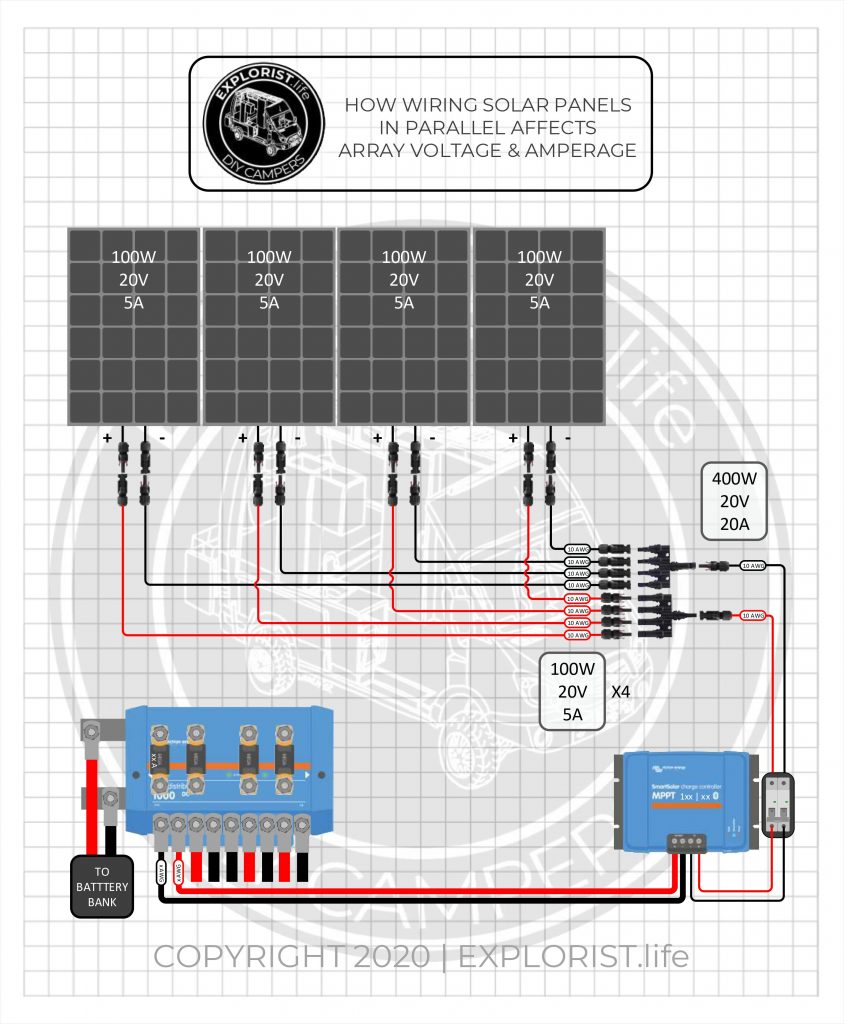
Here we see four – 100w solar panels wired in parallel, which means all of the positive wires are connected and all of the negative wires are connected. Since Wiring solar panels in parallel adds their amperages while their voltages stay the same, we would add 5+5+5+5 amps to get a total of 20 amps at 20 volts heading into the charge controller. We installed 400 watts of solar panels and by using watts law of V x A = Watts we can see that 20 V * 20A equals 400W for 100% array efficiency. This means, of the 400 watts of panels installed, we can expect to see all 400w of power heading into the charge controller under ideal conditions.
How Does Wiring Solar Panels In Series Affect it’s Volts & Amps?
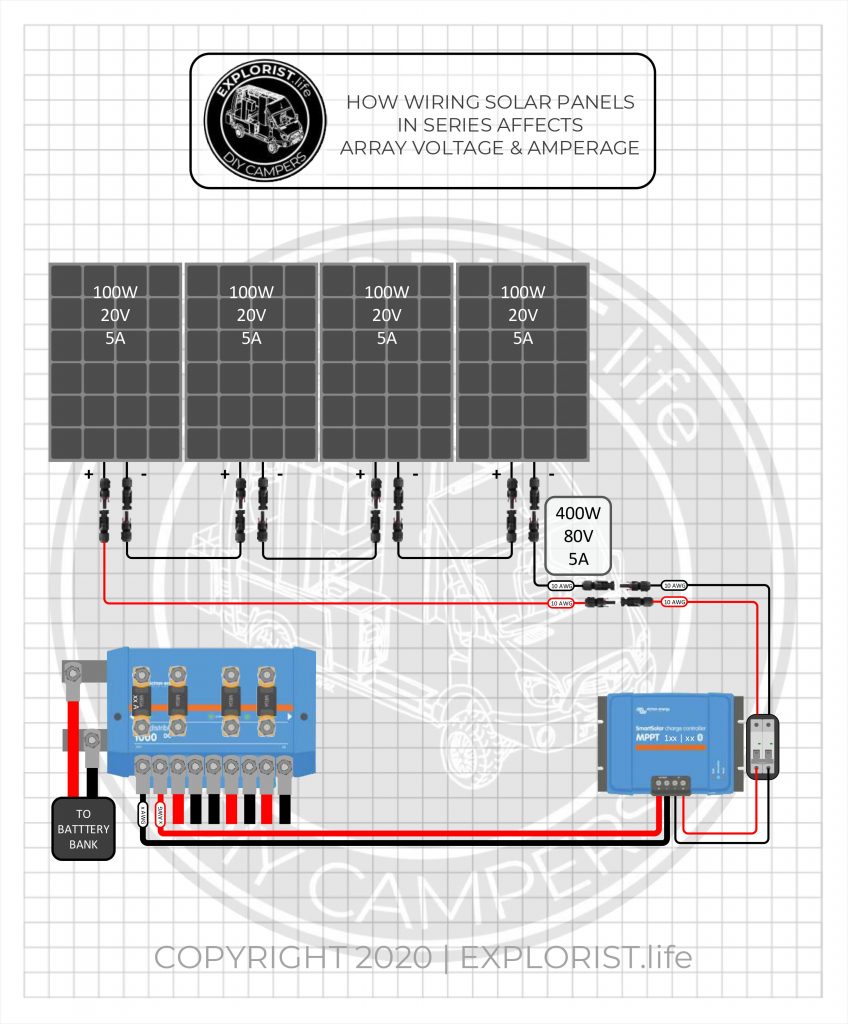
Here we see 4, 100w solar panels wired in series, which means that the positives and negatives of neighboring panels are wired together with the positives and negatives of the end-panels are going to the charge controller. Since Wiring solar panels in series adds their voltages while their amperages stay the same, we would add 20+20+20+20 to get a total array voltage of 80volts and 5 amps heading to the charge controller. We installed 400 watts of solar panels and by using watts law of V x A = Watts we can see that 80 V * 5A equals 400W for 100% array efficiency. This means, of the 400 watts of panels installed, we can expect to see all 400w of power heading into the charge controller under ideal conditions.
How Does Wiring Solar Panels In Series-Parallel Affect it’s Volts & Amps?
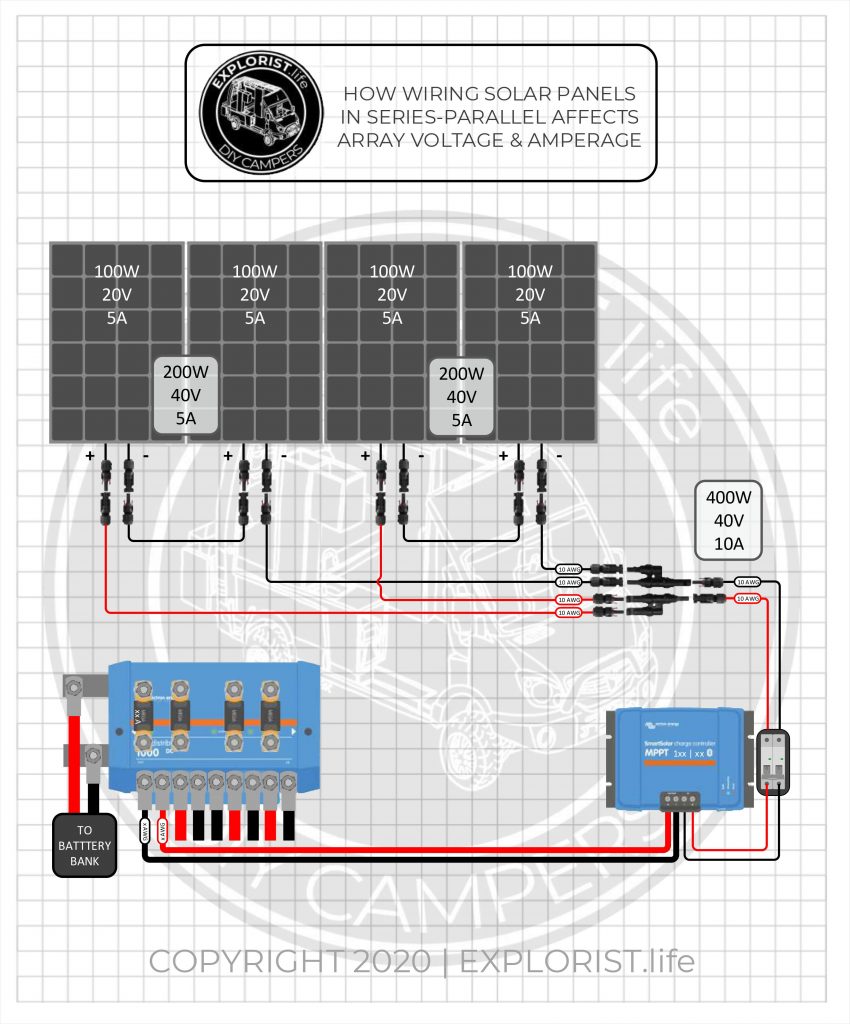
Here, we see 4 100w solar panels wired in series parallel. In this array, pairs of panels are wired in series with the two resulting series strings wired in parallel.
Since solar panels wired in series adds their voltages while their amperages stay the same which means that for each of the two series strings, we would add 20v + 20v which gives us a total of 40v and 5a for each of the two series string.
Since series strings wired in parallel adds their amperages while their voltages stay the same, we would add 5a + 5a for a total of 10A at 40V heading to the charge controller.
We installed 400 watts of solar panels and by using watts law of V x A = Watts we can see that 40 V * 10A equals 400W for 100% array efficiency. This means, of the 400 watts of panels installed, we can expect to see all 400w of power heading into the charge controller under ideal conditions.
Now that we have out solar panel array basics covered; lets’ talk about wiring different sizes of solar panels in the array.
How does Wiring Different Sized Solar Panels Together Affect the Array Voltage & Amperage?
When mismatched solar panel sizes or mismatched solar panel series-strings are wired in parallel or series, the affect is VERY similar to the guidelines posted earlier, except for one change.
- Solar Panels wired in series gets their voltages added while their amps stay at the lowest amperage of the panels in series.
- Solar Panels (or series strings) wired in parallel get their amperages added together while their voltages stay at the lowest voltage of the panels (or series strings) wired in parallel.
What Happens when Different Solar Panel Sizes are Wired in Parallel?
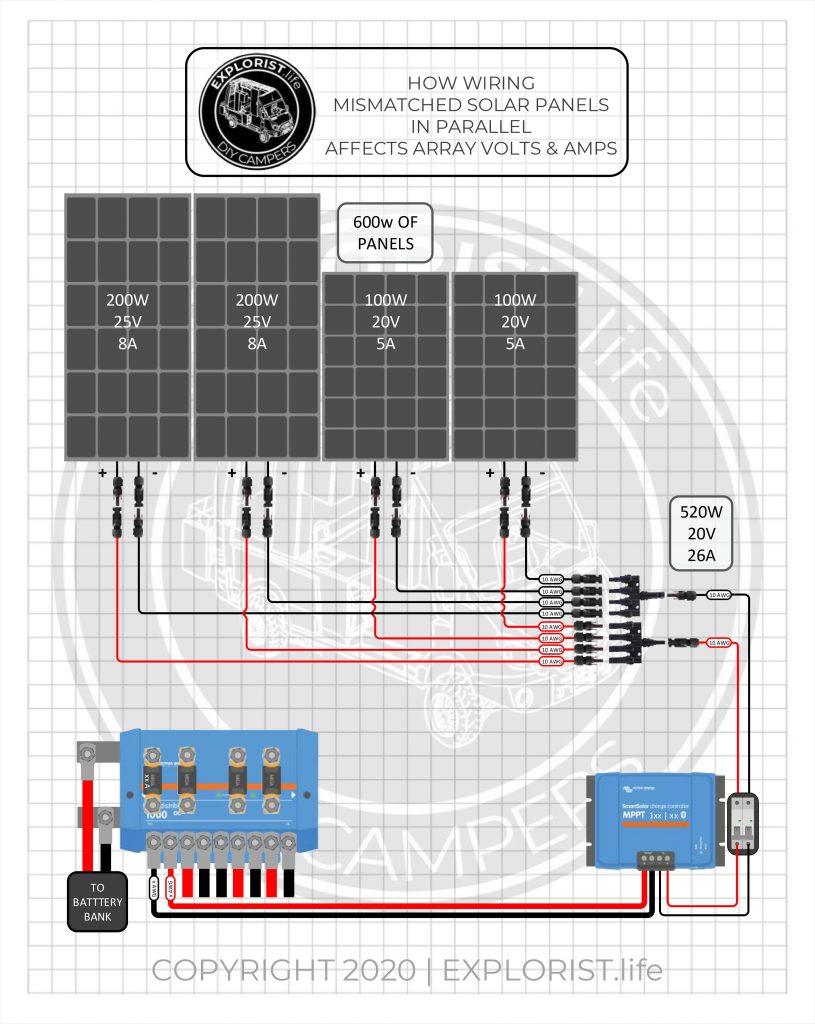
For this example, we have two – 200w solar panels and 2 x 100 w solar panels. The two 100w solar panels are operating at 20V and 5 amps and the 200w panels are operating at 25V and 8 amps.
If we were to wire all of these panels in parallel, solar panels in parallel adds their amperages while their voltages stay the same. This means we would add 8A + 8A + 5A + 5A for a total of 26 amps heading to the charge controller. Now, although the volts stay the same in a parallel wired array, since we have different panel voltages, we must use the lowest common denominator, which is 20V. So we have 20 volts at 26A amps heading to the charge controller.
We installed 600 watts of solar panels and by using watts law of V x A = Watts we can see that 20 V * 26A equals 520W for only 86% array efficiency. This means, of the 600 watts of panels installed, we can expect to see only 520w of power heading into the charge controller under ideal conditions.
What Happens when Different Solar Panel Sizes are Wired in Series?
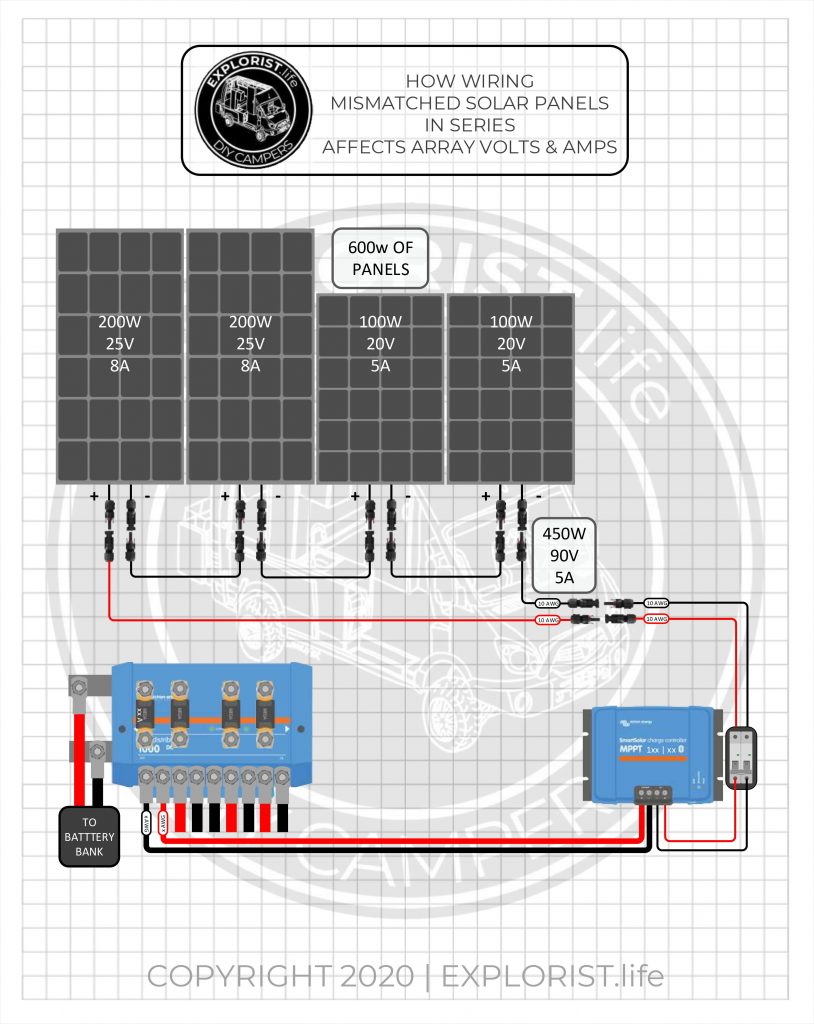
For this example, we have two – 200w solar panels and 2 x 100 w solar panels. The two 100w solar panels are operating at 20V and 5 amps and the 200w panels are operating at 25V and 8 amps.
If we were to wire all of these panels in series, solar panels in series adds their voltages while their amperages stay the same. we would add 25v + 25v + 20v + 20v to get a total of 90 volts heading to the charge controller. Now, although the amps stay the same in series wired arrays, since we have different panel amperages, we must use the lowest common denominator, which is 5 amps. So we have 90 volts at 5 amps heading to the charge controller.
We installed 600 watts of solar panels and by using watts law of V x A = Watts we can see that 90 V * 5A equals 450W for only 75% array efficiency. This means, of the 600 watts of panels installed, we can expect to see only 450w of power heading into the charge controller under ideal conditions.
What Happens when Different Solar Panel Sizes are Wired in Series-Parallel?
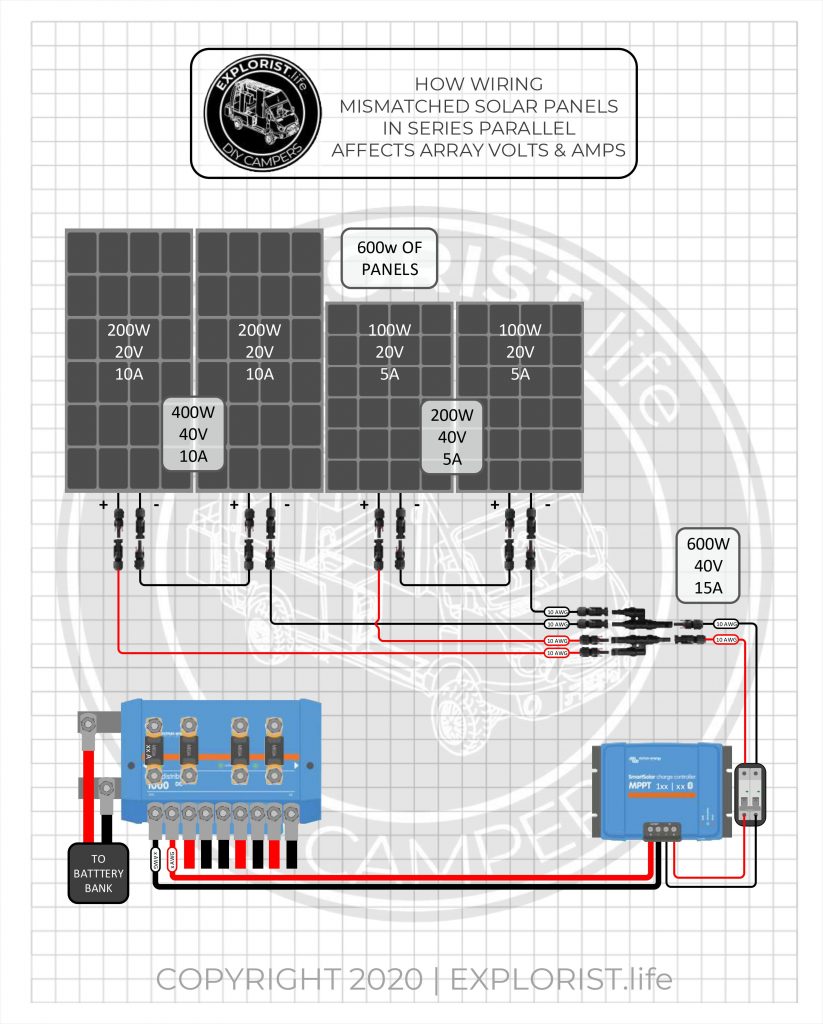
Now, lets say we were able to find solar panels of different wattages, but their voltages are the same, or at least REALLY similar: In the earlier example of mismatched solar panels wired in parallel, our 20V at 26A figure MAY not produce enough array voltage to really let our MPPT solar charge controller do it’s job properly, OR we are installing a 24v battery bank and we need to boost the array voltage to a more appropriate level (Panel array voltage MUST be at leave 5V higher than battery bank voltage).
This array shows mismatched panel sizes of 100w and 200w, but we were fortunately able to find panels with similar voltages.
Wiring the similar wattage solar panels in series would yield 40V at 10A for the 200w panels and 40v at 5 amps for the 100w panels. Wiring those two series strings in parallel would yield 40v at 15A since 10A plus 5A equals 15 amps and the volts stay the same at 40.
We installed 600 watts of solar panels and by using watts law of V x A = Watts we can see that 40 V * 15A equals 600W for 100% array efficiency. This means, of the 600 watts of panels installed, we can expect to see the full 600w of power heading into the charge controller under ideal conditions.
Great! So, we can just always wire similar panels in series and wire those series strings in parallel, right? Not so fast…
When Mixing Solar Panel Sizes is Not Advised
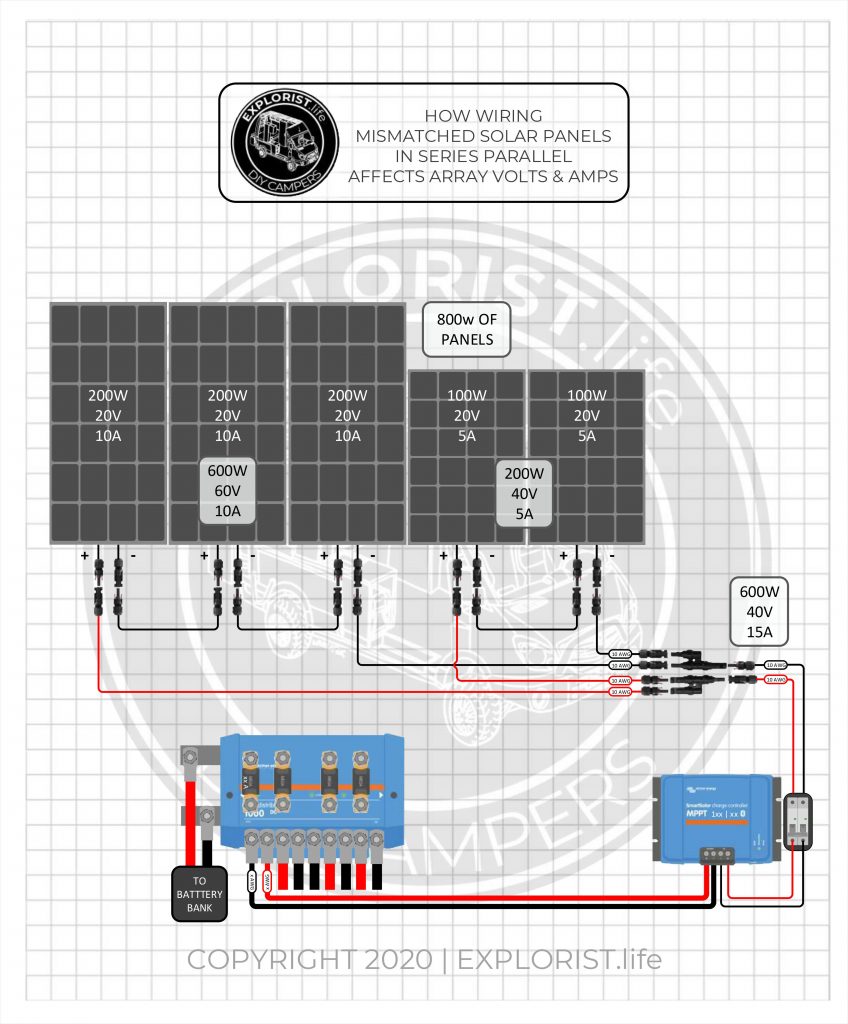
Same solar panels as last time, but if the three 200w solar panels were wired in series and the 100w solar panels were wired in series, then those series strings were wired in parallel, by all of the same math we’ve been using for the previous however-many diagrams, we would end up with 60V at 10A for the 200w series string, 40v at 5a for the 100w series string, and 40v at 15A for the total array.
We installed 800 watts of solar panels and by using watts law of V x A = Watts we can see that 40 V * 15A equals 600W for 75% array efficiency. This means, of the 800 watts of panels installed, we can expect to see only 600w of power heading into the charge controller under ideal conditions, which means that the two 100w panels are effectively useless in this array and by just using the 3, 200w panels in series, we could expect the same amount of power output with fewer panel
What Happens When Dissimilar Solar Panel Series Strings are Wired in Parallel?
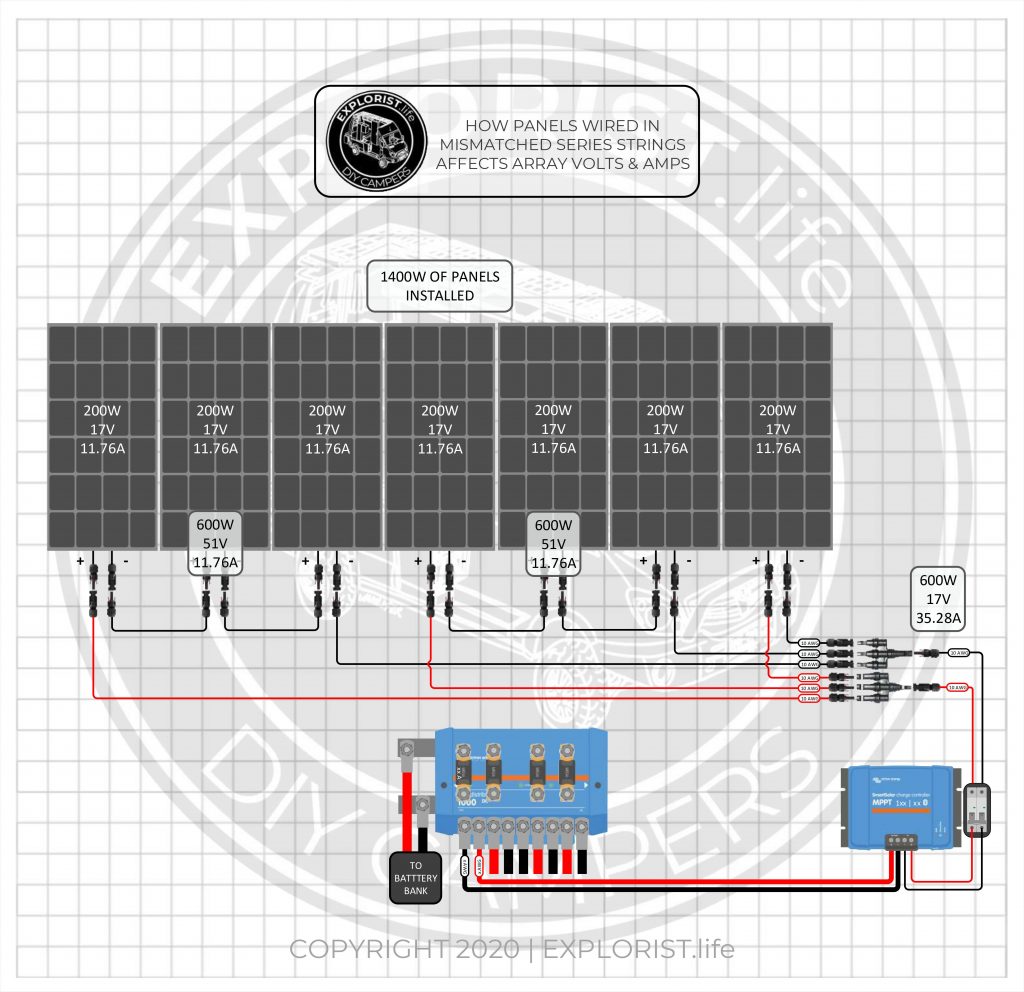
If you are wanting to install, say, seven panels into your array; the only possible ways to wire these without severe power loss are series OR parallel. NOT series-parallel. Here’s why:
These seven 200w panels have operating voltages of 17V and an operating amperage of 11.76A. Let’s say our charge controller has a maximum voltage input of 100V which we must stay below. If we wired the 7 solar panels in series, we would see an array operating voltage of 119V; which would exceed the capabilities of the charge controller (NOTE: When sizing the charge controller; the Open Circuit Voltage AND temperature compensation must be used. More info: https://www.youtube.com/watch?v=MxziHKvTRh8). Wiring in purely parallel is not advised due to reasons we’ve discussed here: https://www.explorist.life/solar-panels-series-vs-parallel/ so to combat these issues, wiring the array in series-parallel is the common fix. Since 7 panels can’t be evenly divided (Those damn prime numbers strike again!), let’s see what happens when 2 series strings of three are wired in parallel with a single panel like the diagram above.
The two series strings get their voltages added while their amps stay the same, resulting in 51V and 11.76A per series string.
The Two series strings and the single panels wired in parallel get their amperages added while their voltages remain at the lowest common voltage from the wires coming into the combiner. This means that the array is operating at 35.28 amps and 17V. Using watts law of Amps x Volts = Watts we can see that 35.28A x 17V = 599.76W. Since we installed 1400W of solar on the roof; wiring as previously described will yield a measly 42% efficiency rate.
Literally omitting the 7th panel and only using 6 panels in a 3s2p configuration would yield twice as much power as having 7 panels wired as previously described.
Another fix – If 7 panels was truly desired in this scenario; a charge controller capable of handling the higher voltage should be purchased so the panels could be wired with all 7 panels wired in series.
Finishing up…
Unequal solar panels CAN be used in the same array, but proper array planning is CRITICAL to avoid array inefficiencies. But… If array inefficiencies are unavoidable, make sure you account for this in your power audit and manage expectations by making sure you understand how these inefficiencies can impact your system performance.
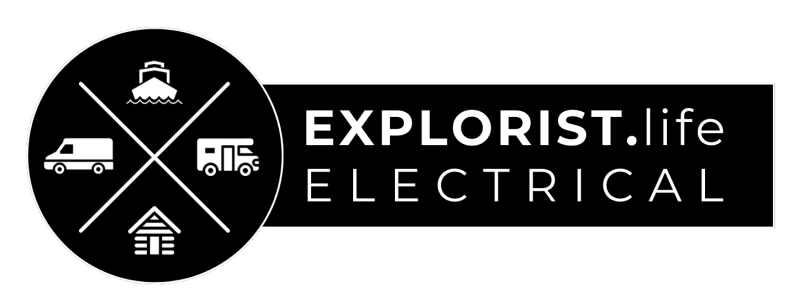


40 Responses
Can I connect mismatched solar panel starting with parallel then the string in series. I have 4 100watts and 2 200watts.
I would recommend wiring the two different sizes of panels each to their own charge controllers. We have solar array wiring kits available for both 4×100 and 2x200w here: https://shop.explorist.life/product-category/all-products/camper-wiring-kits/solar-charging-wiring-kits/
Can I start connect solar panels in parallel the the string in series to the inveters
I’m not really following your question, but here are my recommended ways to set up the solar charging side of your system: https://shop.explorist.life/product-category/all-products/camper-wiring-kits/solar-charging-wiring-kits/
Nate: – I’ve searched your YT channel and Blog AND the web to ad nauseum for an answer to this question. How can I add a separate suitcase solar panel to my existing solar setup? I have 4x180w panels on the roof wired in 2s2p as your calculator recommends. I’d like to add a suitcase panel into that array, if possible without adding another charge controller. But for the life of me I cannot find anything that shows how to make that connection before the MPPT controller. I know you are over the top busy these days, but if you get a minute? Greatly appreciated. TIA
Tony
Basically, you can’t. We could find a way to fabricobble something together with some electrical arts and crafts… but the proper answer is to use a 2nd charge controller for the ground deploy array.
Hey Nate thanks for what you do for the community. I have a roof mounted 200w panel at 22.6 Vmp and 8.85 Imp permanently installed.
I also have a plug-in 100w ground panel that is 18 Vmp and 5.56 Imp
After watching your video the series option looks like the the most efficient (86%) way to go.
……but how do I wire in series to alway have the 200w panel giving power to the charge controller if the ground 100w panel isn’t plugged in?
I’m not adverse to a second controller, however my current one has enough capacity for the panels I have.
The ground panel plugs in through a 50a Anderson connector.
Many OEMs have an outside port for a ground panel so there must be a way.
Thanks in advance,
Shaun
Oof, that would be reallly tough to get to work, logistically. I would recommend wiring as two separate arrays to independent charge controllers.
Thanks for this great insight in as far as solar energy is concerned,
We really appreciate
Hi Nate, I have just purchased a Victron SmartSolar MPPT 150/70-Tr Bluetooth Solar Controller for our 5th wheeler. I am considering putting 5 x 200w (VoC 27v, Isc 9.6A) and 5 x 100w (VoC 24.3v, Inc 5.4A) panels on the roof to charge 500ah of batteries. What is the best way to wire these together? (Series & parallel). Cheers Phil
I would recommend wiring each size to it’s own charge controller. Tutorial for that here: https://www.youtube.com/watch?v=N0UB7LZVduk
There’s no good way to avoid significant inefficiencies for all of those panels on the same array due to what you learned in this blog post.
Hi Nate,
In order to make the most of the free space on our roof, we decided to use three panels from Victron Energy with three diferent sizes – 175W (18.3V / 9.56A), 90W (19.5V / 4.61A) and 30W (18.2V / 1, 66A). It is nonsense to connect such panels in series, but I understood from your article that in parallel it should work with a small loss and with only one solar charge controller (if I calculate correctly, I would get 288 W from 295 W panels). I have no real experience myself, but a lot of people told me that due to large differences in size, it may not work so well and the losses will be much greater. Can I ask for your opinion?
Many thanks in advance. And thanks for your articles, they help us a lot.
Ondra
The solar array should REALLY be at least 20V higher than the battery bank charging voltage for optimal MPPT charge performance. I think 3 single panels of different sizes will, in general, struggle.
I only have 2 solar panels. 1x310w and 1x370w. Both same brand. Can I series these two solar panels? btw, I have 40A solar charge controller.
The blog post you just commented on will teach you what happens when you wire different sizes of charge controllers together. 🙂
Hi Nate
Your blog and videos have been invaluable to me. Best I’ve seen anywhere by far. I literally spent all day yesterday reading and watching your content but I can’t seem to find information about my particular situation.
I have a single 300w panel on my RV (voc 39.85, lmp 9.3). I’m thinking of getting three new 360w panels (voc 43.9, lmp 9.82). What would my total system output be if I connect the 300w panel with one of the 360w panels in one series string then the other two 360w panels in a second series string (then both strings parallel)? Can I use a 150/100 charge controller in this situation?
If this isn’t a good idea, I’ll just toss the 300w panel and get four of the 360w panels so they are all matched.
Thanks so much for your help!
Hey Brian! For the sake of education… you tell me. 🙂 This blog post teaches you how to figure out what you are asking.
For sizing a charge controller, you’ll also need some of the temperature coefficients, but here’s how you figure that out: https://www.youtube.com/watch?v=MxziHKvTRh8
Hi Man,
I think I’ve seen most of your videos and checked most of the blog, but I’m stuck in the middle:
I got 3x 440W, 48.3V open circuit (STC rating) @ 11.5A panels. If I connect in series, it’ll be 144.9V @ 11.5A My (Growatt) MPPT is 145V open circuit V max, and 80A max. It was just OK, until I saw your temperature compensation video. Now I’m afraid I’ll fry the MPPT if I go to Alaska. I still want to go there…
So my thinking is to parallel connect them, so V will stay at 48.3, and A jump to 34.5. The problemo is that I only have an AWG 10 wire. From what I read is that AWG 10 is up to 30A max… what would you recommend?
Thanks a bunch in advance!
This array is a perfect candidate to go with a charge controller with a higher voltage input rating like this: https://battlebornbatteries.com/product/victron-smartsolar-mppt-250-100/?afmc=explorist_bb67
I would recommend wiring the panels in series and going with that charge controller I just linked.
Hey man, amazing blog, thank you so much for all this info!!
I have a question, a friend bought 2 solar panels, for his diy van conversion, one of 200W and another of 120W. Which would be the best connection he could do? Thanks in advance for your answer. Much love
Diego from Germany
For the sake of education (and the fact that I do not know the voltage or amperage of the panels in question)… Based on the information I’ve provided in this blog post… what do YOU think is the best way? 🙂
great tutorial.
Thanks! 😀
Hi Nate.
Firstly thank’s for this super blog.
Secondly have patience with my newbie question and not so good English.
I already have a system installed on my motorhome but I want to expand it with five more Victron panels of 175 W each connected in series. I have bought a Victron regulator 150/85 which according to your Solar Charge Controller Calculator, will work with my five new Victron panels and thus give me 875W. My old system is 2 Büttner Black Line panels of 130W each with a separate Büttner 260 MPPT controller connected to my 2 x Super B 160Ah Lithium Iron Phosphate battery.
My question is if I can keep the old system with the existing controller and also connect the charging current from the new controller directly to the battery? Will this work or do I have to take into account something else.
My new regulator is not enough to connect all seven panels in series as the system’s total voltage exceeds 150.
Any ideas?
Regards
Ornulf
I would recommend wiring them in two separate arrays with two separate charge controllers. If you use Victron SmartSolar MPPT charge controllers, the controllers can ‘talk’ to each other to coordinate charging efforts.
I wonder if you could confirm my calculations and let me know if I’ve failed to consider anything:
I have 2 – 190W panels 9.3A and 20.4V
I want to add more panels to the roof of my trailer but am space limited, so the most I can do is 2 50 or 60W panels. Newpowa makes a 60W “24V system” panel that puts out 1.89A and 33.54V
If I string all 4 panels in parallel, I calculate:
9.3 + 9.3 + 1.89 + 1.89 = 22.38A
multiply that with the lowest voltage (20.4) gives me 457W out of the 500W panels. Correct?
Thanks.
Hello Nate! I’ve got 6 solar panels total, three 120W, wired in parallel, and three 100W wired in parallel, these are 2 separate arrays. I wired them this way for the charge limitations of the goal zero yeti 3000 with two charge controllers. I now have the yeti 3000X which only has one charge controller. What would happen if I wired the two arrays already wired in parallel in series? Would my amps and volts both be compromised by the lowest common denominator? Keep up the great work and thank you for everything you do!
For the sake of learning something new… what numbers did you come up with? This blog post teaches you how to come up with those numbers; so what is your conclusion?
I currently have 12×330 watt panals in 2 strings of6 I would like to add 4 more but would like to add the 4 to 1 string so I would have 1 string with 6 panels and the other with10 .the open circuit voltage on the panel is 36.18 v and amp isc is8.40v my inverter has the following specifications voc of500 and mppt range of up to 450v. How will this arrangement effect my power output?
Based on the information provided in this blog post, how about you tell me? 🙂 What does the math tell you?
I have a roof mounted solar system of three 170 watt Zamp Solar Panels which I’m connecting to a Victron SmartSolar 100/50 charge controller. My RV also has a side mounted Zamp Solar port which I was planning to connect my 200 watt Zamp Portable Panel (with built in PWM controller to so that I could tilt and optimize. it’s position relative to the sun for max efficiency. I know thing should work OK as they are using independent solar controllers but what are the inefficiencies associated with this setup? I believe the best solution would be to replace the ZAMP PWM controller on the portable panel with a Victron SmartSolar controller so that they could communicate and coordinate their charging via Bluetooth, correct?
Correct. 🙂
Hi Nate. Love your videos on YouTube. I have a question about connecting my two battle born varieties in parallel. Do the cables have to be the same length? I’m relocating my batteries to inside of my pass through in my 5th wheel. Before I had them oriented front to back, so I made the cables the same length. Now, they are placed where the negative terminals are farther apart than the positives.
Ideally yes; they should be the same length.
Hi Nate, First of all, excuse my English, I don’t know how to speak it and I’m sending you this translated with Google, I hope you understand me … I have a motorhome that has a factory installed 120 W solar panel with a 14A PWM controller (which is integrated into a manufacturer’s switchboard) and a 220Ah and 12V AGM battery. Now I want to install a new PERC 445W solar panel with a Victrom 100-30 MPPT regulator, I have done the calculations and in very cold days the amperage would be limited to 30A but that at a theoretical level, I doubt very much that the solar panel will give that power. My question is, do you think it is a good idea to power the same 12V 220Ah AGM battery from the two independent solar systems, from the old one with its PWM and 14A and from the new one with its 30A MPPT? If the answer is negative, why?
Greetings and a thousand thanks,
Sure! You can use two seperate charge controllers, but they should be able to coordinate their charging efforts for fastest charging. The Victron SmartSolar MPPT charge controllers can do this via bluetooth.
Thanks Nate, the problem is that it is not possible to make the solar regulators work together, the PWM is integrated in the motorhome control unit … what really worries me is that by not working together the PWM could damage the battery, in fact I have thought about installing a Victron battery protect to minimize the risks.
I also plan to monitor the entire system with a Victron Cerbo GX
Cheers,
Wow, that’s an irony I didn’t expect! I have one 100w panel in my RV and I’m about to add a new 75w panel in parallel with the first. Would I be correct in assuming that if they both put out the same voltage (or close to it) that I would yield the full, additional charging power of the second, 75w panel?
For the sake of education… When you take your actual panel specs from the sticker on the back; what does the math tell you? I’ve taught you how to figure this out; give it a shot. 🙂
Thank you my friend y learn a lot from you